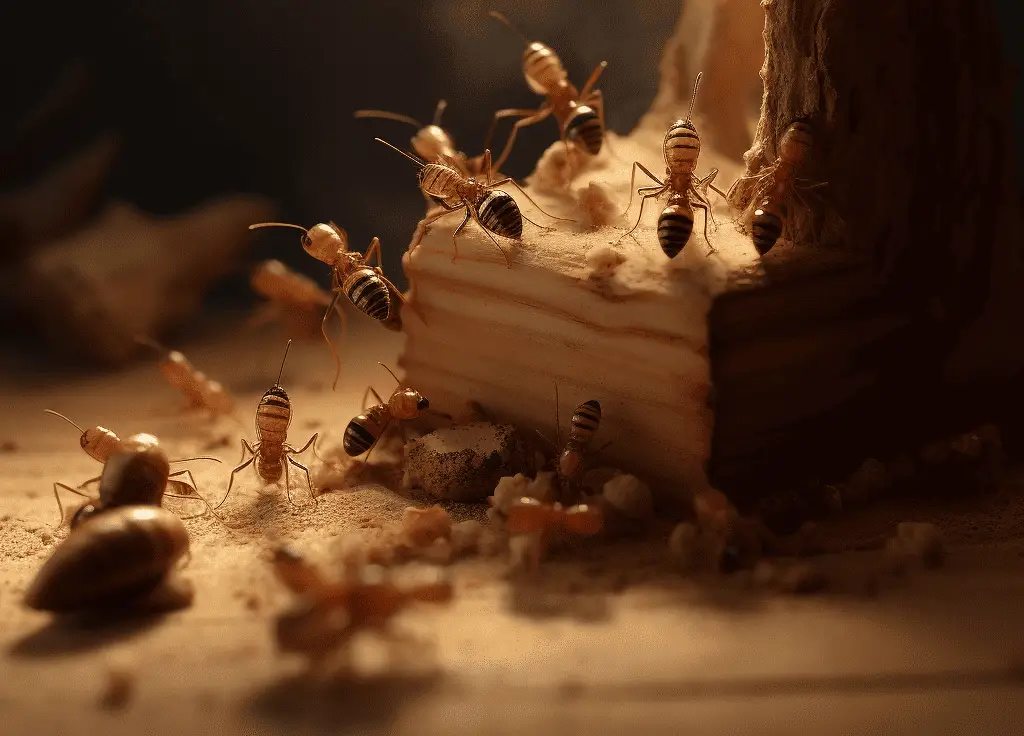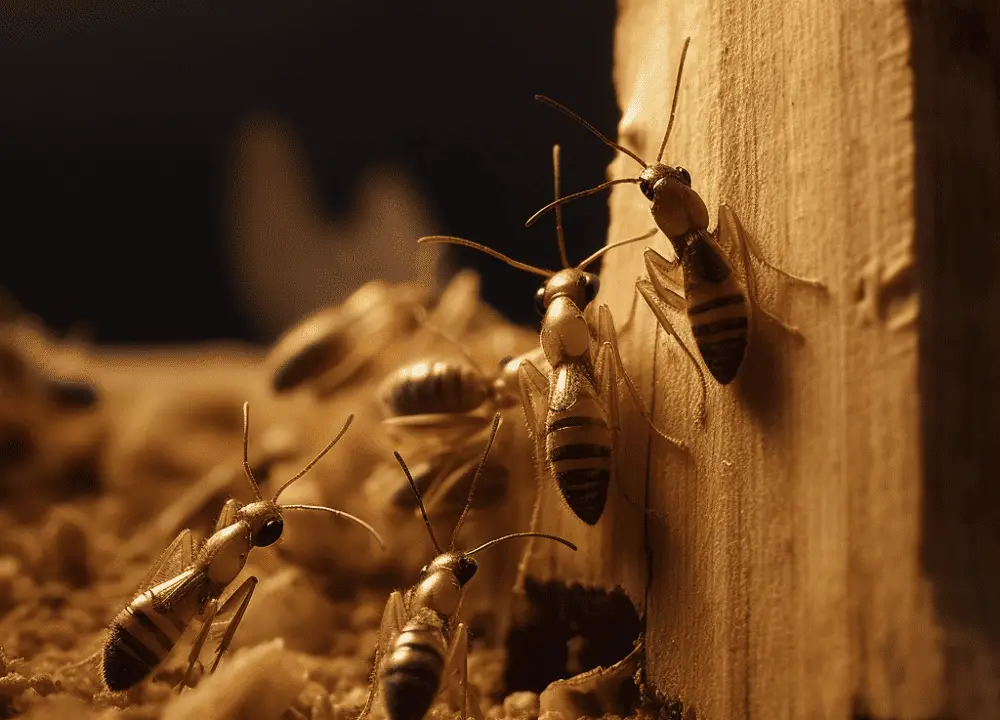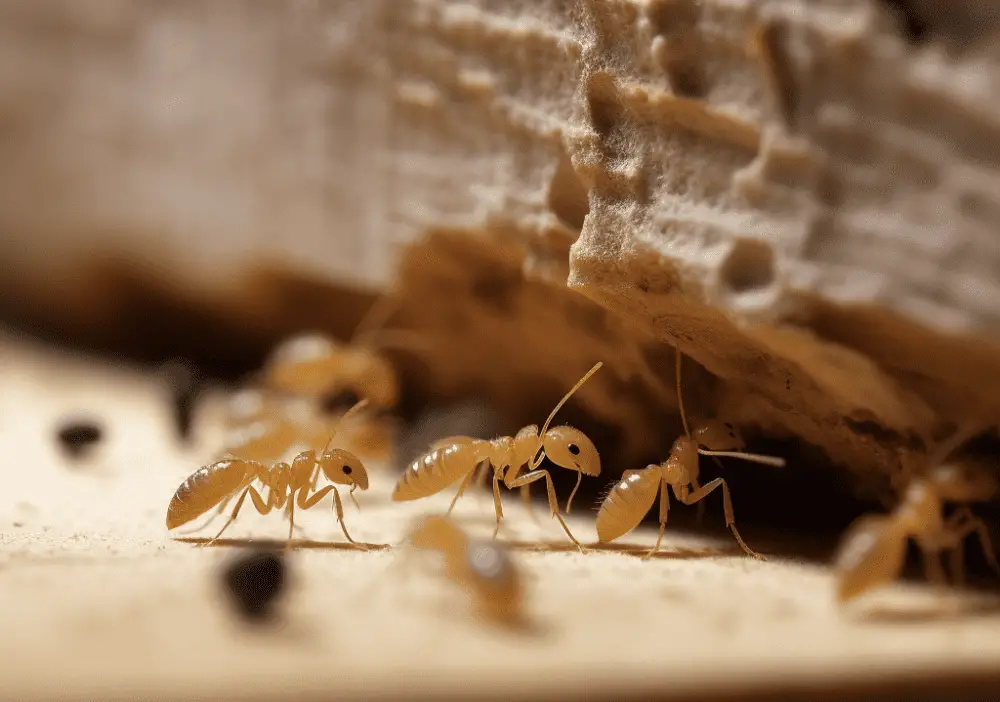Termites are notorious for causing significant damage to homes, devouring wooden structures, and potentially compromising the integrity of a building. Homeowners often face the question of whether it’s safe to live in a house with termites.
To ease the anxiety and guide you through this issue, let’s discuss the safety aspects and potential hazards associated with sharing a living space with these wood-destroying insects.
Termite infestations do not pose direct harm to humans, meaning that they will not bite or transmit diseases like some other pests can. However, the degree of safety in a termite-infested home greatly depends on the size and severity of the infestation and the damage caused by the insects.
An early sign of termite presence is the presence of mud tubes, which provide a protective passage for termites to travel between their colony and food source. Spotting these tubes on your walls, ceilings, or foundations is an indication that your home may be at risk.
Identifying a Termite Infestation
Termites can cause significant damage to homes, and early identification is crucial. In this section, we’ll discuss the signs of termites and the primary types: Subterranean and Drywood termites.
Signs of Termites
Termites can leave a variety of clues to their presence in your home. Some of the most common indications of a termite infestation include:
- Mud tubes: Subterranean termites build these small, cylindrical tunnels near foundations and crawl spaces.
- Swarming: The presence of termite swarms, which are made up of winged reproductive termites, can signal a termite infestation.
- Galleries: Termites create galleries or tunnels in wood as they consume it. You may notice a hollow sound when you tap on such areas.
- Small holes: You might spot tiny holes in walls, flooring, or wood as termites create entry and exit points.
- Frass: Drywood termites produce fecal pellets, called frass, which are often found near infested areas.
Types of Termites: Subterranean and Drywood

There are two main types of termites that infest homes: Subterranean and Drywood termites.
Subterranean Termites are primarily found underground and build mud tubes to reach wood. They need a moist environment to survive and are typically found in areas with soil or damp wood. Key features of a Subterranean termite infestation include:
- Mud tubes near foundations or crawl spaces
- Swarms of winged termites are often found during warm, humid days
Drywood Termites live inside dry, undecayed wood. They do not require close contact with soil and are more likely to infest furniture or exposed wood in homes. Some indicators of a Drywood termite infestation are:
- Small holes in wood or walls
- Frass piles found near infested areas
- Less likely to create mud tubes, as they don’t require the same level of moisture as Subterranean termites
Structural and Property Damage Caused by Termites
Extent of Structural Damage
Termites are small insects that can cause significant structural damage to your home if left unchecked. They feed on cellulose, which is found in wood and other plant materials. Over time, this can weaken the structure of your home and lead to costly repairs.
The extent of the damage caused by termites can vary significantly depending on the type of termite, the size of the infestation, and how long the termites have been present in the home. In some cases, they may cause minor cosmetic damage, such as small holes in wood or drywall.
In other cases, the structural integrity of the building may be at risk due to extensive termite damage.
Damage to Wooden Structures
Termites are particularly attracted to wooden structures within a home, which can include framing, beams, and floor joists. They can hollow out the wood, reducing its strength and stability and ultimately compromising the structure of your home. This type of damage can be quite extensive and may require professional intervention to adequately repair.
Potential areas of damage can include:
- Wooden framing
- Support beams
- Floor joists
- Roof supports
- Window and door frames
Effects on Foundations and Flooring
Not only do termites target wooden structures, but they can also cause damage to the foundations and flooring of a home. This is due to their ability to move through small cracks and crevices in search of food. They can create tunnels through concrete and masonry, which may lead to the weakening of these materials.
Damage to foundations and flooring can include:
- Cracks in concrete and masonry
- Tunnels created by termites in search of food
- Weakened flooring due to termites feeding on wooden subfloors
While it’s essential to be aware of the potential for termite damage, not every home with termites will experience severe structural problems. By catching an infestation early and getting professional help, you can minimize the impact of termites on your home and ensure its long-term safety and stability.
Health Risks Associated with Living in a House with Termites
Termites can pose potential health risks to homeowners and residents, particularly when it comes to allergic reactions, asthma, and mold and moisture issues.
Let’s dig deeper into these potential hazards.
Allergic Reactions and Asthma
Termites may not directly cause allergic reactions, but their presence can aggravate existing allergies and trigger asthma attacks. Termites break down cellulose from wood, which produces dust particles that can become airborne. These particles may cause irritations to the skin, eyes, and respiratory system.
Affected individuals may experience the following symptoms:
- Skin rashes: Termites increase the risk of red, itchy rashes forming on the skin due to continuous irritation.
- Eye irritation: Termites contribute to increased dust levels, leading to dry and itchy eyes.
- Respiratory issues: People who suffer from asthma or respiratory allergies may experience exacerbated symptoms, including coughing, wheezing, and difficulty breathing.
Mold and Moisture Issues
Moisture in your home can be both a cause and a consequence of a termite infestation. Termites are attracted to damp, humid conditions, and when they infest a house, they create moisture-rich environments ideal for mold growth. Mold releases spores into the air that can cause negative health effects, including:
- Allergies: Exposure to mold spores can trigger allergic reactions, including sneezing, runny nose, sore throat, and persistent coughing.
- Asthma complications: Mold spores can provoke asthma attacks by irritating the airways and causing inflammation in sensitive individuals.
- Respiratory infections: Prolonged exposure to mold spores may result in an increased risk of respiratory infections.
To minimize these health risks, it’s crucial to address both termites and mold issues promptly. Contact a professional pest control expert to treat the termite infestation and consult a mold specialist to ensure proper removal and remediation of mold growth.
Termite Inspection and Treatment Options
Home Inspections and Termite Inspections
When considering the safety of living in a house with termites, it’s crucial to conduct a thorough home inspection to identify any existing issues. Home inspections cover a variety of concerns, including electrical, plumbing, and structural problems.
A termite inspection should be conducted alongside the home inspection to identify the presence of termites, evaluate the extent of the damage, and recommend treatment options.
DIY Solutions vs. Professional Pest Control
While DIY solutions may seem like a cost-effective option, they might not be effective in all situations. DIY treatments may only provide temporary relief and may not eliminate the underlying problem. Conversely, professional pest control services have the expertise to identify the extent of the problem and provide long-term solutions.
Pest inspectors can recommend the most appropriate treatment methods based on the type of termite and the severity of the infestation. Terminating the termite infestation may require spot treatment, termite fumigation, or other termiticides.
Treatment Methods: Baiting, Liquid Insecticides, and Fumigation
There are different treatment methods to eliminate termites from your home, including baiting, liquid insecticides, and fumigation.
- Baiting: This method involves placing baits around the home, attracting termites to feed on the bait and bring it back to their colony. The bait contains slow-acting toxic substances that gradually kill off the entire colony. Baiting is an eco-friendly option and doesn’t require drilling or chemical application within the home.
- Liquid Insecticides: Termiticides are applied directly to the soil surrounding the home, creating a protective barrier that prevents termites from entering. Liquid insecticides can be effective for up to five years, depending on the product. Regular checks and maintenance are necessary to ensure the barrier remains intact.
- Fumigation: For severe infestations, fumigation might be the recommended treatment. It involves tenting the entire structure and releasing fumigant gases that penetrate walls, floors, and other areas where termites are hiding. This method is highly effective but requires the occupants to vacate the home for several days.
In some cases, heat or cold treatments may also be used to treat localized termite infestations. These methods involve raising the temperature above 120°F or lowering it below 15°F for a specific period to kill the termites.
However, these treatments are not suitable for large-scale infestations and should be conducted by professional pest control services.
Preventing and Managing Termite Infestations

Preventative Measures and Home Maintenance
To minimize the risk of a termite infestation in your house, it’s crucial to take proper preventative measures. Subterranean termites thrive in moist environments, while drywood termites seek out dry wood. Implementing proper ventilation and moisture control can help prevent both types of termites.
- Ventilation: Ensure that your home has proper ventilation to reduce humidity, particularly in crawl spaces and attics.
- Moisture control: Repair leaks in your home’s plumbing and roof to prevent moisture buildup.
- Wood care: Keep firewood, lumber, and other wood materials away from your house to avoid attracting termites. Use treated lumber for any new construction projects.
Professional Assistance and Ongoing Monitoring
If you suspect your house has termites, it’s essential to seek professional assistance to eradicate them and implement ongoing monitoring. Pest control specialists can provide various treatment options, such as baiting and chemical treatments.
- Baiting: Pest control specialists can install bait stations around your home. These stations contain wood or a cellulose-based material with a slow-acting poison that termites will feed on and bring back to their colony, potentially eliminating the entire colony over time.
- Chemical treatments: Professionals can apply liquid termiticides to the soil around your home to create a barrier that stops subterranean termites from entering your house. They can also inject chemicals directly into the wood to treat drywood termite infestations.
To prevent future infestations, pest control specialists can also provide ongoing monitoring through regular inspections and by maintaining the effectiveness of bait stations. This proactive approach will help you maintain a termite-free home and minimize the risks associated with living in a house with termites.
Considering Buying a House with a Termite Infestation
Evaluating the Pros and Cons
For homeowners considering buying a home with termites, it’s essential to weigh the pros and cons before making a decision. On the one hand, a small infestation may not be a deal-breaker and can be easily treated with proper intervention. Additionally, the presence of termites might allow for some negotiation on the sale price.
On the other hand, dealing with a termite infestation can be costly, with treatments and repairs potentially adding up. There is also a risk that the infestation has caused substantial property damage that may be costly to fix.
Dealing with Property Damage and Repairs
First and foremost, it’s advised to have a home inspection contingency in your purchase agreement. This allows you to evaluate the extent of the termite infestation and any related property damage. If the findings are alarming, you may choose to walk away from the sale or negotiate the purchase price to account for the required repairs.
To deal with termites and the potential damage, hiring a licensed contractor and a professional termite control service is strongly recommended. They will help identify the root cause of the infestation, develop a plan for treatment, and provide guidance on repairs or home improvements to prevent future infestations.
It’s important to be prepared for the potential costs associated with treatment and repairs.
Summary: Is It Safe to Live in a House with Termites?
While it’s not ideal, living in a house with termites isn’t typically considered an immediate health hazard. However, potential risks may arise over time from their feeding and nesting habits in the home. These risks include structural issues, water damage, and further infestations.
Termites often go unnoticed, so it’s crucial to be aware of any signs pointing to their presence, such as soft spots in wooden structures and mud tubes. Active termites can cause significant problems to your home’s structure, potentially compromising its stability.
Additionally, water damage caused by termites can weaken the foundation and worsen existing issues.
The risks of living with termites should not be ignored. It is essential to address the infestation promptly to minimize potential damage.


